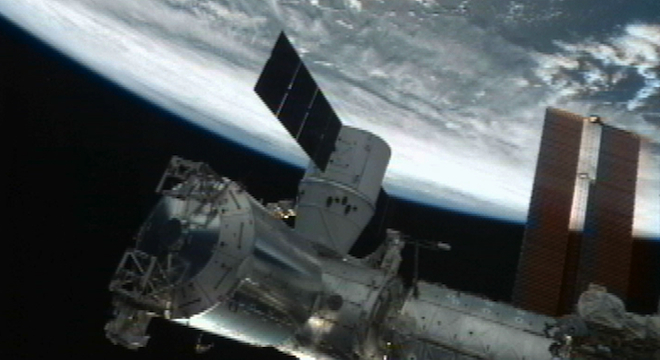Updated 3:05 p.m. EDT, Wednesday, October 10
A future of routine commercial cargo deliveries to humans living in outer space came just a bit closer to reality on Wednesday when SpaceX successfully joined its unmanned Dragon cargo capsule to the International Space Station orbiting some 250 miles above the Earth at a speed of over 17,000 miles per hour.
“Looks like we’ve tamed the Dragon,” said NASA astronaut Sunita Williams, the current commander of the International Space Station (Expedition 33), who, along with her colleague, Japanese flight engineer Aki Hoshide, captured the SpaceX Dragon craft from 32 feet away using the space station’s robotic Canadarm-2 at 6:56 a.m. E.D.T.
Williams had earlier tweeted that she was practicing to “snare” the dragon, referring to herself and her colleagues as “Dragon slayers.”
It took another two and a half hours worth of checks and procedures before the astronauts actually pulled the Dragon, which contains 882 pounds of supplies for the crew of the space station and equipment for science experiments, to its docking port.
The type of procedure is known as a “berthing,” not technically a docking, as the Dragon didn’t connect with the station under its own power. SpaceX successfully performed the first-ever berthing in outer space by a private company in May, also delivering cargo to the space station, but that was just a test-run and didn’t contain mission critical supplies.
Here’s a NASA photo from the view of the International Space Station of the Dragon approaching the station from underneath:

Here’s a view from a camera aboard the Dragon of the approaching International Space Station:

Here’s another NASA photo from the view of the International Space Station of the Dragon at its 30 meter (98 feet) “hold point” waiting to be grappled:

The Dragon capsule will remain docked to the space station for the next 18 days, during which the time the space station’s crew of three (Williams, Hoshide and Russian cosmonaut Yuri Malenchenk) will unpack and transfer all the cargo from the capsule into the station. They’ll also restock Dragon will some 1,673 pounds of return cargo — including 866 pounds worth of finished experiments and biological samples from outer space.
Samples include blood and other biological material from the crew and plant matter, which will be used to better understand the effects of microgravity on “bone health, blood chemistry and hormonal changes.”
The capability to return scientific samples to Earth for analysis here is a critically important capability one, which only Dragon and the Russian Soyuz capsule are capable of at this time.
As Marybeth Edeen, deputy manager for the International Space Station Research Integration Office, said in a NASA statement about Dragon’s sample return capability:
“While some of this data can be obtained by on orbit analysis, many analysis techniques have not been miniaturized or modified to allow them to be performed on orbit, which means sample return is the only way to obtain this data.”
The SpaceX Dragon is due back on Earth on October 28, when it is set to de-couple from the space station and use its engines to re-enter the atmosphere and plunge into the Pacific, to be retrieved by SpaceX.
SpaceX’s Dragon capsule also made it into orbit this time around despite an engine failure on the company’s Falcon 9 booster rocket, which SpaceX acknowledged and explained was similar to other engine failures on successful NASA Apollo Saturn V rockets.
Though it didn’t impede SpaceX’s and NASA’s primary mission to deliver cargo to the International Space Station, the engine failure did result in the secondary payload — a communications satellite from the company Orbcomm — being released at an incorrect, lower-than-intended orbit, as Reuters reported.
The mission marks SpaceX’s first of 12 contracted re-supply runs to the International Space Station under a $1.6 billion deal with NASA. SpaceX aims to eventually provide crew transport services for NASA via a modified Dragon capsule, with SpaceX founder and chief technology officer Elon Musk recently saying the first crewed test flights would likely take place in the next three to four years.
Late updates: NASA on Wednesday afternoon published the following two videos on YouTube, the first showing the SpaceX Dragon capture and berthing procedure and the second revealing the space station crew opening Dragon’s hatch for the first time earlier Wednesday:
Also updated to add information relating to SpaceX’s error with the secondary payload in the story copy.






